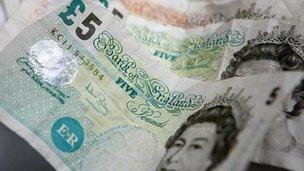Cheer up: It could be much worse
- Published
- comments

The Office of Budget Responsibility's gloomy forecasts of lacklustre economic growth, living standards squeezed more than at any time since the 1930s and rising government debt could - it admits - turn out to be optimistic.
How so? Well, those forecasts assume (in its own words) that "the euro area finds a way through the current crisis and that [eurozone] policymakers eventually find a solution that delivers debt sustainability."
It adds that a "more disorderly outcome is clearly possible" and that "this poses a meaningful downside risk".
Last night, there was a bit more of what most people these days call "muddling through" by eurozone finance ministers. They agreed the terms and conditions of how to enlarge the firepower of the bailout fund, the European Financial Stability Facility, to somewhere between 830bn euros and 1.25tn euros.
According to the EFSF, this still involves a two-pronged approach: the EFSF will provide guarantees against the first 20% to 30% of losses on new loans to countries that are struggling to borrow, to make it easier for the likes of Italy to raise vital finance; and it will create new funds containing its resources and those of other investors, which will then lend to the likes of Italy.
As for when this new money will actually be available to help an Italy or Spain, well the EFSF says it will "implement these two approaches to be ready early in 2012".
Which means that although Italy is currently being forced to borrow at penal, unsustainable rates (see my post yesterday), it's on its own for a good few weeks yet.
For what it's worth, eurozone finance ministers are also muttering about finding additional resources for bailouts, by having their respective national central banks lend to the International Monetary Fund, which would then lend the money back to any eurozone country that was unable to borrow in the conventional way.
They need to find extra money from somewhere, because Italy's financing requirements just next year could exhaust almost half of the EFSF's promised extra firepower - and, to be frank, there are still technical obstacles to the EFSF actually securing that firepower.
So it would be dangerous for the eurozone to rely on the EFSF alone to bring calm to debt markets.
But whether the idea of Italy's debt being "mutualised" (or shared with German taxpayers) via some kind of shield provided by the IMF will appeal to the German parliament and German central bank - which are set against any such central-bank lending to any eurozone member state - seems highly doubtful.
And since it is impossible to see such an IMF initiative without the participation of Germany, as the biggest and strongest European economy, you have to wonder whether eurozone finance ministers are straw-clutching (again).
So we're likely to go through Christmas and the new year with the eurozone on the edge of a precipice - which also means that our economy is too close to the big drop for comfort.
Quite how near was signalled by the ratings agency Fitch yesterday, which said that OBR's forecasts of rising government debt had reduced the UK's capacity to absorb further shocks and retain its AAA rating.
To translate, if the eurozone melts down, there will be a double whammy for the UK: our biggest export market would implode; and our banks would find it both much harder and more expensive to borrow (because those who lend to them would see them as too exposed to eurozone losses), which in turn would choke off the supply of necessary credit to companies and households.
So UK economic activity would contract hard and fast. We'd be back in a very painful recession. And since tax revenues would inevitably slump, the government's deficit would inevitably widen.
Hey presto: toxic mix of weak banks, rising unemployment and government debt increasing even faster than the OBR expects. And (not that it would remotely matter when the real living standards of people would be collapsing) our AAA would be history.
Which is why, in case you have been wondering, it matters to us that eurozone governments do muddle through to what the OBR calls "debt sustainability".
Update 08:57: There was a big jump in what eurozone banks deposited at the European Central Bank last night to just under 300bn euros - which shows that they're even more fearful than they were of lending to each other.
The increase over the past fortnight in what they are placing at the ECB is more than 100bn euros.
Eurozone banks are opting for the security of lending to the central bank at a paltry interest rate over earning a proper return by putting their money to work. It shows how anxious they are.
And it also shows that parts of the eurozone are close to a credit crunch, if not already in one.
Update 09:48: There's a bit of additional stress in banking markets today following the decision by Standard & Poors to downgrade a load of big international banks.
Every big British bank has been downgraded by S&P a bit - which is to be expected, given the government's policy decision to lessen the strength of the guarantee that they'll be bailed out in all circumstances.
In respect of the eurozone, it's probably not surprising that an Italian bank, BNL, and a Spanish bank, BBVA, have suffered the double whammy of being downgraded and being put on "negative" outlook, which means they could be downgraded again.
Also mighty Deutsche Bank is on "negative outlook", which means it could be downgraded.
All that said, investors attention and fears are directed mainly to Bank of America, which is now on a relatively low rating, and could be downgraded further.